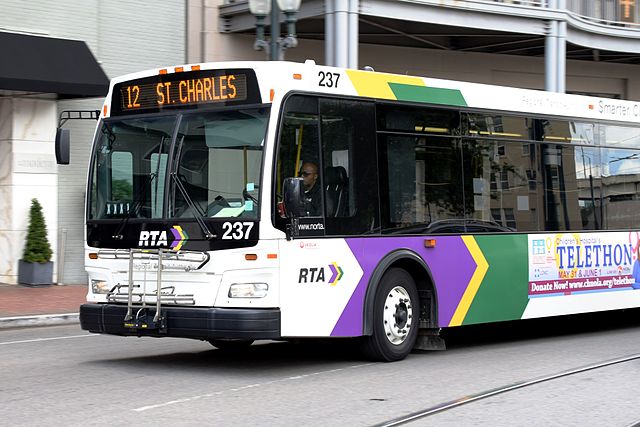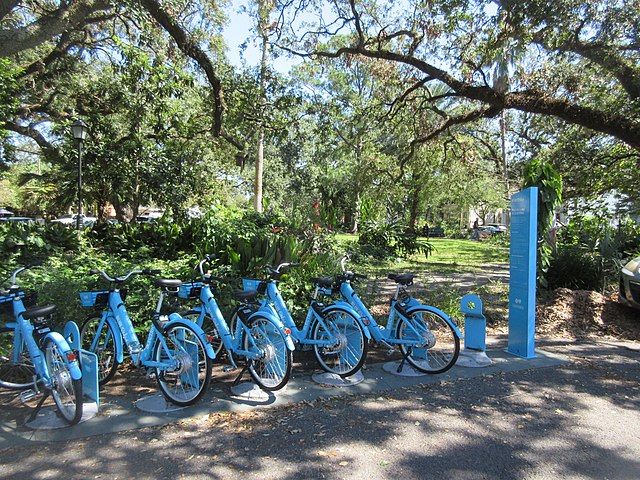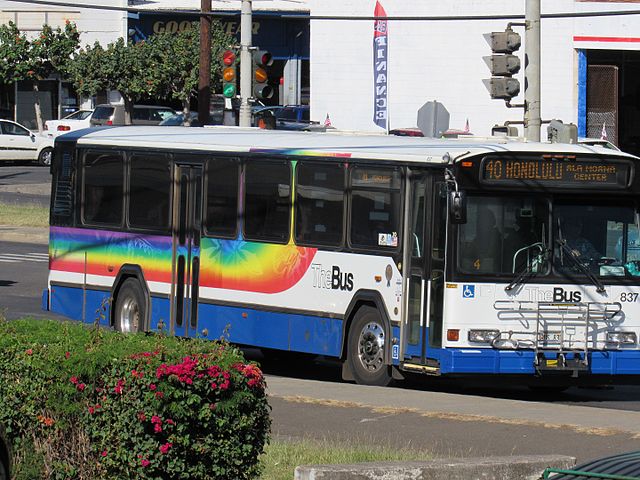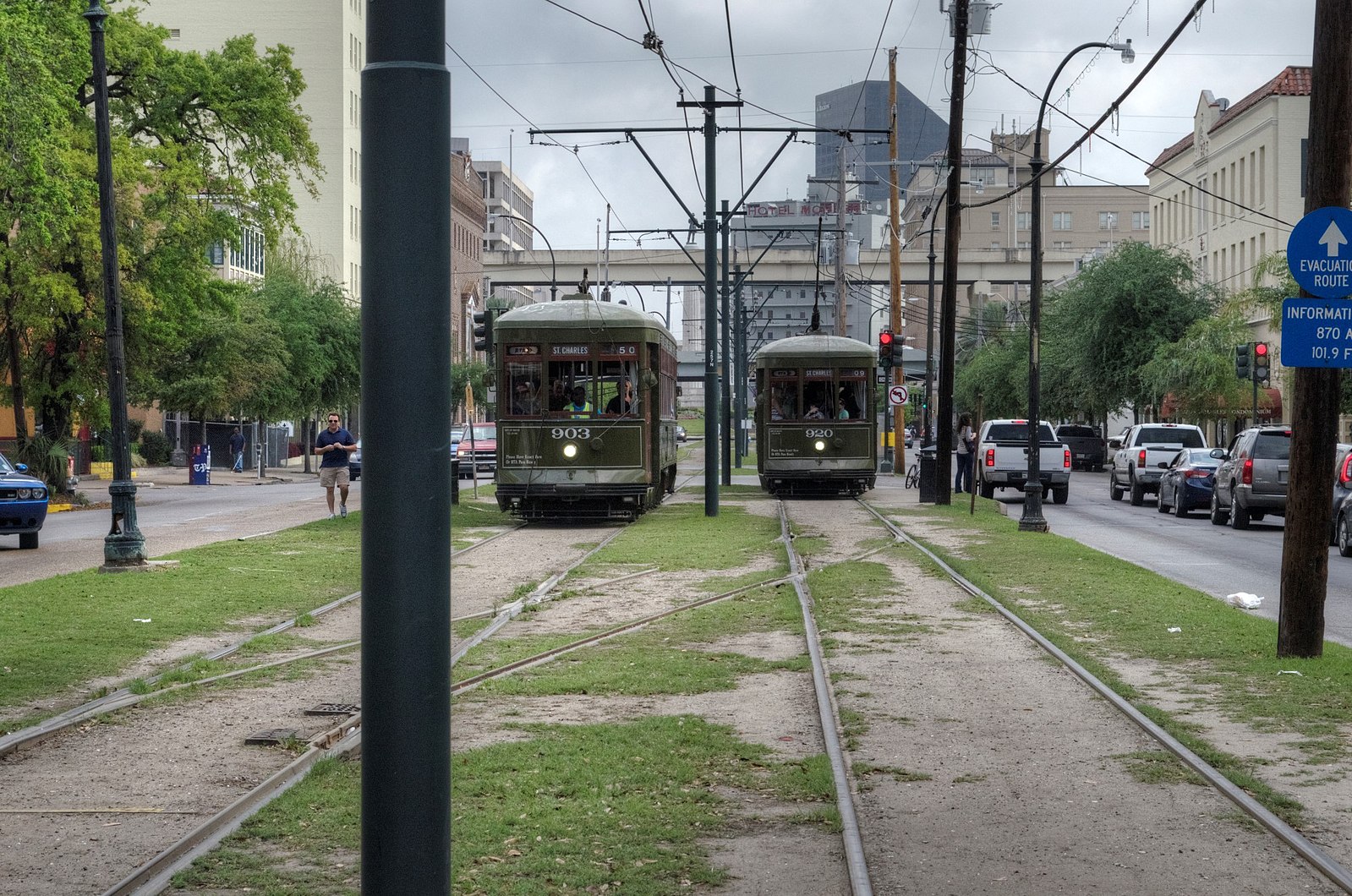Part I: The problem
Public transportation systems are beneficial to communities in many ways, but they are often overlooked due to limited media coverage. Public transportation boosts local economies, reduces air pollution and traffic congestion, increases mobility, and saves users money. If there are so many advantages to public transportation, why is it a system that is so neglected in communities?

RTA bus. (Photo By: Wikimedia Commons)
In cities, public transportation is the link between people and their jobs. The problem in New Orleans is that only 12% of jobs are accessible within 30 minutes or less by public transportation. The minute percentage of jobs accessible by public transportation dramatically shrinks the pool of jobs available to those without a car. While there are buses and streetcars, they are proven to be unreliable due to constant delays and long wait times.
After Katrina wiped out New Orleans’s transportation network in 2005, the city had an opportunity to rebuild and modernize its system, but unsurprisingly, this didn’t happen. On a policy level, when there are no requirements for public transportation to connect workers to their jobs, the focus shifts to investing in systems for tourists and affluent areas, leaving outer areas disconnected. The areas that are left disconnected are oftentimes the people who need access to these public transportation systems the most. Since New Orleans is so focused on its tourists, these transportation systems are prioritized in wealthy neighborhoods that would appeal to tourists, such as uptown. On the St. Charles streetcar, this is very noticeable as it passes huge mansions and big oak trees that glamorize New Orleans. New Orleans has become increasingly an economically divided city. Uptown’s wealthier neighborhoods, which have access to their own cars, also enjoy access to the city’s four trolley lines, whereas the poorer, more spread-out neighborhoods only have access to the sparse bus network.
While this may not have a huge impact on someone who owns a car, it dramatically affects those who cannot afford the cost of maintaining and insuring a vehicle. New Orleans has one of the highest poverty rates in the nation, with 23.65% of its population living in poverty and 19% of households without access to a car. Public transportation in New Orleans continues to prove itself to be unreliable and inaccessible to those residents who need it the most.
This lack of reliable public transportation in New Orleans hinders residents’ ability to work and get out of poverty. Since they are limited to the small number of jobs accessible by public transportation, it expands the poverty cycle issue for many residents. In a city where high rates of poverty are so prevalent, something as vital as public transportation should be prioritized. Public transportation is supposed to be a convenient and efficient way to get around a city, but without these elements, it is essentially useless. According to a study of upward mobility based at Harvard, commuting time is the single most important factor in escaping poverty. The longer the commute, the less likely it is that low-income families will be able to move up the socioeconomic ladder. There is a direct link between transportation and social mobility that is stronger than a lot of other factors that are often looked at. Those in poverty in New Orleans are quite literally being closed off from the opportunity to escape the poverty cycle by the lack of public transportation available.

Blue Bikes back in New Orleans. (Photo By: Wikimedia Commons)
Blue Bikes, another mode of public transportation in New Orleans, is conveniently available only in the Lower Garden District, CBD, French Quarter, Bywater, and Midcity – areas with the highest tourism. This does not help workers get to their jobs; it is just another way to make money off tourism while failing the city’s residents. The rideshare program operates through an app, rendering it inaccessible to those without smartphones. The app only has a mere 2.1 stars out of 5 and numerous bad reviews from locals themselves. One user wrote, “Locals deserve better service and treatment. This service is not affordable and designed for the middle class and tourists. The support staff are ignorant, and they charge fees like crazy for an affordable bike share program that’s sponsored for the city” (user: rollerskatebitch). Unfortunately, Blue Bikes is another form of public transportation that’s proven to be unreliable and inaccessible for locals in New Orleans.
New Orleans needs to begin prioritizing its residents over tourists. After all, the locals are what give New Orleans its culture and meaning that drives all the tourism. New Orleans needs to be held accountable for its lack of accessible and reliable public transportation, and that begins with cultivating coverage of this issue in the media.
Part II: The Solution
The solution-based response can be found by looking closely at Honolulu’s public transportation system. The Honolulu bus system is ranked as one of the best transit systems in the world, with over 69 million bus riders each year. The bus transit system serves two million people per day, representing 85% of the population. According to Jaime Lerner, a beacon for creative and sustainable urban planning, “It’s not a question of scale, and not a question of money. Every city in the world can improve its quality of life in less than two years”.

Honolulu’s TheBus. (Photo by: Wikimedia Commons)
Honolulu’s bus system serves the entire island of Oahu, which is approximately 44 miles long and about 30 miles wide. As of 2022, TheBus’ fleet consists of 518 buses and 207 paratransit vehicles. You can buy a singular ride for $2.00, a daily pass for $5.50, or a monthly pass for $70.00. They offer separate fare prices for those with disabilities or Medicaid $2.00 daily, $6.00 monthly, and $35.00 annually. Buses typically run every 15 or 30 minutes, depending on the line, which provides a reliable and simple schedule. TheBus spends 74.4% of its budget on wages and benefits each year and focuses on compensating its workers properly. TheBus also has 542 fixed-route buses for the island. Honolulu’s TheBus also continuously takes steps to be more eco-friendly by using renewable resources and recycling materials.
Oahu Transit Services Inc. privately manages TheBus under a public-private partnership with the City and County of Honolulu Department of Transportation Services. A public-private partnership is a long-term partnership between two or more public and private sectors. Private capital finances government projects and then draws profits from taxpayers and users throughout the contract.
In 2008, Honolulu began planning public transit-human service transportation coordination. The 2009 Plan was to improve transportation services for people with disabilities, low-income, and seniors by improving the coordination of all publicly funded transportation on the island. This plan addressed the gaps and needs in transportation services in Honolulu and developed an action plan that detailed prioritized projects. The projects were funded in part through federal funds but the first round of projects demonstrated the benefits of implementing strategies detailed in the plan. FTA Section 5316- Job Access and Reverse Commute (JARC) Program funded local projects that offered job-access transportation to low-income people and the funds were to pay for up to 50% of operating costs and 80% for capital or Mobility Management costs.
In 2020, Honolulu received more than $5.9 million in federal funding to improve its transportation systems. Honolulu acquired 6 new zero-emission electric buses that run 24 hours a day on route 40. The goal for Honolulu is to make a transition to a zero-emission, entirely electric bus fleet within the next 15 years. They want to be able to provide affordable transportation while also reducing their carbon footprint to be more eco-friendly. The increase in federal funding will help make it more convenient for workers to commute and customers to visit local businesses. Honolulu also received a grant from the Federal Transit Administration’s Low or No Emission program after partaking in an intensive application process, competing against other municipalities across the country.
While implementing solutions takes time, Honolulu has shown dedication to improving its public transportation systems to benefit its locals. They have made it clear that their locals are a priority over tourists, and they want to take steps to help make things easier for them. The island has done extensive research and thought of different ways to make public transportation accessible to a variety of groups- not just the wealthy. They have considered low costs, environmental factors, and efficiency and taken those with disabilities into account, among many other factors, to improve their systems. Honolulu has also shown they are holding itself responsible and taking accountability when it comes to public transportation and acknowledged its importance to those on the island.
Part III: Implementation
New Orleans’s public transportation systems currently consist of the streetcar, buses, the ferry, and Blue Bikes. The streetcar and the bus cost $1.25 for a single ride or you can pay a flat rate for unlimited rides for one day for $3.00, three days for $9.00, five days for $15.00, or one month for $55.00. New Orleans’ public transportation is run by New Orleans Regional Transit Authority (RTA) which is a public transportation agency. The Board of Commissioners is in charge of making major decisions for the RTA and sets fares, oversees service and operations, develops operating budgets, approves the year’s annual transportation development plan, and decides purchases and expansions.

ST. Charles streetcars. (Photo by: Wikimedia Commons)
There are five streetcar lines in New Orleans, including St. Charles Line, the Riverfront Line, the Canal Street Line, the Loyola Avenue Line, and the Rampart/St. Claude Line. St. Charles Line runs from Canal Street to the end of St. Charles, then out South Carrollton Avenue to its terminal at South Carrollton and Claiborne. The Canal Street Line runs the length of Canal Street into North Carrollton Ave to the City Park entrance on Esplanade. The Riverfront Line runs parallel to the river from Esplanade Avenue, past Canal Street, to the convention center above Julia Street. The Rampart/St. Claude Line runs along Loyola Ave from New Orleans Union Passenger Terminal to Canal Street to Elysian Fields. There are 34 bus lines and 251 bus stops, but it is unclear how many buses they have now post Katrina. There are two ferries in New Orleans, one connects Chalmette and Algiers, and the other takes riders from the French Quarter/CBD to the Algiers Point neighborhood.
The RTA app that many riders use to plan their trips and track their chosen mode of public transportation tends to be tricky and unreliable. The app is often inaccurate in the time frames it gives you, so people either end up missing their car or bus or being way too early and having to wait. The app needs to be updated and redesigned in order to be more accurate and reliable for its users. This can help a lot in predicting times and stopping all the delays.
Another issue that can be fixed is the inaccessibility of the St. Charles streetcar line. The vintage streetcars on the line were not wheelchair accessible until recently, and even now, only three of the St.Charles streetcars are equipped for wheelchair accessibility, and it was only done because RTA was sued. This is unacceptable as every single one should be wheelchair accessible. This would be an easy fix to be more reliable for the disabled and shave off wait times.
In order to generate funds to help update New Orleans’s public transportation and to add more lines, like in Honolulu, the city should apply for grants. There needs to be a shift in the motivation to fix public transportation for New Orleans locals. There should be more drive and dedication to help residents improve their lives as they make the city what it is. The board should come up with more in-depth plans to improve the city’s transportation systems and use the plans to generate funding from the public or private sectors. To generate more funds for the cause, there needs to be increased media coverage. Right now, there is rarely any media coverage on this matter, and therefore no one notices or cares. If accessible and reliable transportation for the people of New Orleans is advocated for, more people will join in to fight for it.
Only a few measures need to be taken to improve the public transportation systems in New Orleans immensely. It starts with a commitment to the cause, and from there on out, it’s easy. Looking at Honolulu’s simple yet extremely effective and reliable bus line can significantly improve New Orleans as it is also a small city. There is no need for fancy or high-tech transportation, just reliable and accessible.
Sources
Bizjournals.com, https://www.bizjournals.com/pacific/news/2020/05/29/honolulu-to-receive-nearly-6m-for-public-transit.html.
Blue Bikes Nola – New Orleans Bike Share, https://bluebikesnola.com/#map.
Bouchard, Mikayla. “Transportation Emerges as Crucial to Escaping Poverty.” The New York Times, The New York Times, 7 May 2015, https://www.nytimes.com/2015/05/07/upshot/transportation-emerges-as-crucial-to-escaping-poverty.html.
“Coordinated Public Transit – Human Services Transportation Plan (CSP).” Coordinated Public Transit – Human Services Transportation Plan (CSP), https://hidot.hawaii.gov/administration/stp-2/coordinated-public-transit-human-services-transportation-plan-csp/.
The Equality of Opportunity Project, http://www.equality-of-opportunity.org/data/.
Hawaii Public Radio | By Noe Tanigawa. “Honolulu Rapid Transit—Maybe A Bus?” Hawai’i Public Radio, 14 Feb. 2019, https://www.hawaiipublicradio.org/arts-culture/2017-02-03/honolulu-rapid-transit-maybe-a-bus.
Living, Hawaii, and Hawaii Living. “How Big Is Oahu?” Oahu Real Estate, 1 Mar. 2017, https://www.hawaiiliving.com/blog/how-big-is-oahu/.
“New Orleans’ Transit System Still Hasn’t Recovered, 10 Years after Katrina.” Grist, 19 Aug. 2015, https://grist.org/cities/new-orleans-transit-system-still-hasnt-recovered-10-years-after-katrina/.
“New Orleans, Louisiana Population 2022.” New Orleans, Louisiana Population 2022 (Demographics, Maps, Graphs), https://worldpopulationreview.com/us-cities/new-orleans-la-population.
“Public–Private Partnership.” Wikipedia, Wikimedia Foundation, 18 Mar. 2022, https://en.wikipedia.org/wiki/Public%E2%80%93private_partnership.
Snyder, Tanya. “What Went Wrong with New Orleans Transit?” The Agenda, 20 Nov. 2018, https://www.politico.com/agenda/story/2018/11/20/new-orleans-public-transportation-000796/.
“Take the BRT Survey.” New Orleans Regional Transit Authority – RTA Home, https://norta.com/.
TheBus, http://www.thebus.org/default.asp?f=y&m=main.
Todd, Cameron Quincy. “Getting around New Orleans: Guide to Public Transportation.” TripSavvy, TripSavvy, 22 Oct. 2020, https://www.tripsavvy.com/new-orleans-guide-to-public-transportation-4689161.
Wherevermag, https://www.wherevermag.com/does-honolulu-have-good-public-transportation/.
WWNO – New Orleans Public Radio | By Tegan Wendland. “Transportation in New Orleans: Still A Long Way to Go.” WWNO, 7 Aug. 2019, https://www.wwno.org/latest-news/2019-08-07/transportation-in-new-orleans-still-a-long-way-to-go.
 NOLAbeings Multimedia artist Claire Bangser created NOLAbeings as a portrait-based story project that marries...
NOLAbeings Multimedia artist Claire Bangser created NOLAbeings as a portrait-based story project that marries...  Voodoo in New Orleans: Reviving history: New Orleans fortune telling This article takes a deep dive into the history of Voodoo in New Orleans, its hybridization with Catholicism, and its present-day place in the city's culture. The author visits fortune-tellers in the French Quarter, using their guidance as a tool for introspection rather than a deterministic predictor of the future. Through her experiences in New Orleans, the author feels a mystical connection to both the past and the future.
Voodoo in New Orleans: Reviving history: New Orleans fortune telling This article takes a deep dive into the history of Voodoo in New Orleans, its hybridization with Catholicism, and its present-day place in the city's culture. The author visits fortune-tellers in the French Quarter, using their guidance as a tool for introspection rather than a deterministic predictor of the future. Through her experiences in New Orleans, the author feels a mystical connection to both the past and the future. 